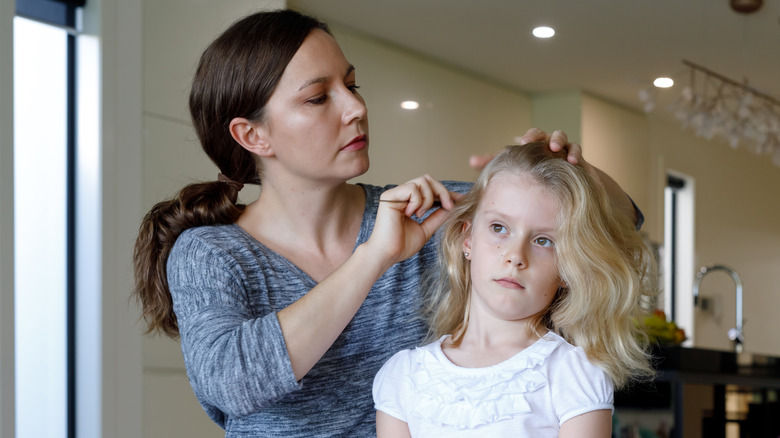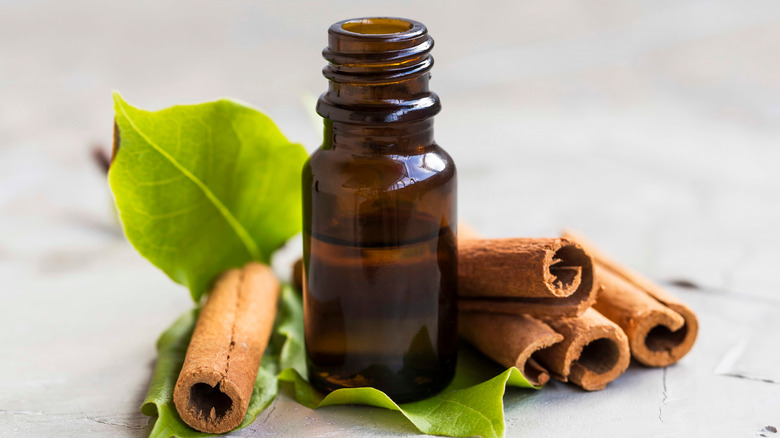The Essential Oil That May Help Banish Lice From Your Head
When we think of parasites that feed on a human host, a tick is the first insect that most likely comes to mind. However, head lice are also in this category. These sesame seed-sized critters can inhabit the human scalp, eyebrows, and eyelashes, reports the U.S. Centers for Disease Control and Prevention (CDC). Although they're unable to fly or jump, they can be transferred from one person to another if you were to have direct hair contact with a person infested with lice.
Most often, head lice infestations are seen in young kids. It is thought that between 6 million to 12 million cases of head lice occur annually across the country in children ages 3 through 11. Schools and daycare centers can present a high risk of transfer.
Thankfully, however, there are natural treatment options for head lice infestations that may help do away with these unwelcome guests. One such option is the topical use of essential oils, specifically cinnamon leaf oil, reports Healthline. So what is it about cinnamon that potentially deters lice? Let's find out.
Cinnamon leaf essential oil may be toxic to lice
What gives cinnamon its signature kick is cinnamaldehyde, according to a 2014 scientific review published in Evidence-based Complementary and Alternative Medicine. While this may be what draws people to the spice in the first place, cinnamon's spicy flavor and aroma is what sends lice running for the hills, according to pest control company Pesky Little Critters. With an aversion to strong odors, lice interpret pungent scents as a warning sign and subsequently steer clear of the source.
Contact with cinnamon leaf oil is also purported to kill off lice. In an early 1996 study published in Complementary Therapies in Nursing and Midwifery, researchers looked at peppermint, red thyme, tea tree, aniseed, nutmeg, pine, rosemary, and cinnamon leaf essential oils to determine their efficacy in treating head lice infestations. Through laboratory testing, the study team found that cinnamon leaf essential oil was among the six out of eight essential oils that proved effective in treating head lice in combination with an alcoholic solution and when rinsed the next day with a mixture of water, vinegar, and essential oil. The phenols, ketones, and oxides found in these essential oils were thought to be the primary sources of lice toxicity.
Is cinnamon oil more effective than chemical treatments?
While cinnamon leaf essential oil may hold potential in treating head lice, some research shows that it may not be any more effective than standard chemical treatments. Researchers from a 2017 study published in the Journal of Zanjan University of Medical Sciences and Health Services outline how permethrin is among the most common topical insecticide treatments used against head lice infestations. However, the more permethrin is used, the progressively more resistant the parasites become to it. In comparing the efficacy of eucalyptus oil, cinnamon oil, and permethrin in treating head lice, the researchers found no statistically significant difference between using permethrin shampoo or cinnamon shampoo to kill off lice eggs (or nits). Rather, eucalyptus oil proved to be most effective in eliminating nits.
Because some people may prefer more natural treatment options compared to chemical products, it may be worth giving cinnamon leaf oil a try if you or a member of your household ever find yourself faced with head lice. To do so, combine four or five drops of cinnamon essential oil with 3 tablespoons of jojoba oil and 3 tablespoons of extra virgin olive oil (per StyleCraze). Once blended, lather the mixture onto your scalp and let it sit under a shower cap for approximately four or five hours. Afterward, brush out the length of your hair with a nit comb and finish off by giving your hair two thorough rinses.



